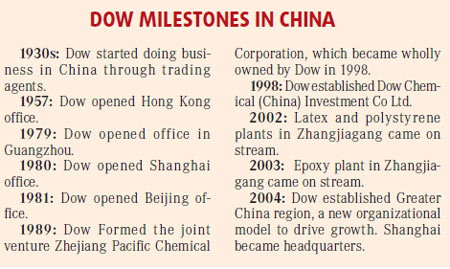
|
BIZCHINA> Top Biz News
 |
|
Related
Dow acts like a Chinese company
By Wan Zhihong (China Daily)
Updated: 2008-12-08 07:59
A glorious torch, crowds of people and colorful flowers are Jim McIlvenny's beautiful memories of taking part in the Beijing 2008 Olympic Games Torch Relay in Tianjin this summer. "What has impressed me the most are the people," says McIlvenny, the US-based Dow Chemical Company Asia Pacific & Greater China president. "Giving me a warm welcome and taking photos with me enthusiastically. They didn't treat me like a foreigner. I felt I am just one of them." "It's the same with our company's business in China," he says. "We act like a Chinese company." After taking the Dow Greater China president position in 2004, McIlvenny is leading the US chemical giant to do more localization within the country. Today Dow delivers a broad range of products and services in China, connecting chemistry and innovation to help provide everything from fresh water, food and pharmaceuticals to paints, packaging and personal care products. China has become Dow's third largest market, after the US and Germany. In the Asia Pacific region, the Chinese market has accounted for around 50 percent of its sales. Last year Dow's sales in China were $3.3 billion, compared with $17 million 30 years ago. "Given our rapid growth rate in the country, we expect China to become our second largest market within a few years," says McIlvenny. "Apart from generating a great number of sales, China is a very important source for our talents," he says. Grow with China
Dow first entered the Chinese market in the 1930s and today the company still keeps some invoices and receipts from that time. Dow opened its office in Hong Kong in 1957 and with the reform and opening up of the Chinese market, it opened its first office in the Chinese mainland in Guangzhou in 1979. In 2004 Dow established the Greater China region, a new organizational model to drive growth. The company moved its China headquarters from Hong Kong to Shanghai the same year. Dow made its first manufacturing investment in China in Ningbo in 1989. Today the company operates 10 manufacturing sites across Greater China. So far the company's largest manufacturing sites in the country are in Zhangjiagang, Jiangsu province where there are three plants producing latex, epoxy and polystyrene. Dow has so far invested over $500 million in Greater China. In 2006 the company announced the intention to invest an additional $400 million on new manufacturing and R&D facilities, including building new plants in Zhangjiagang. "Our past 30 years of development in China went through three stages," says McIlvenny. "In the first 10 years we used the imported products to build a market in the country." At that time most of Dow's customers in China were international companies, he says. In the second stage the company began to build local talents and put more focus on domestic customers. "Now our development in China is in the third stage, which is to build full local capabilities and capacities," says McIlvenny. Dow now has over 2,500 people in China. However, the figure was only 200 a decade ago. In the company's offices in Shanghai, the staff has increased from 60 to over 1,000 in the last five years. The company is building a new Dow center in Zhangjiang High-Tech Park in Shanghai, which is scheduled to open early next year. The center will become a major business and innovation hub for Dow in the Asia Pacific region. Dow is also developing more local assets to support growth. In 2007 the company signed a cooperation agreement with China's largest coal company Shenhua for a feasibility study of a world-scale coal-to-chemicals complex in Shaanxi province. The project will use clean coal technologies that convert coal to methanol to produce ethylene and propylene, the building blocks of various plastics and chemical products. The feasibility study will include an environmental impact assessment, water supply, front-end loading engineering design, market and product mix, logistics and supply chain, and an economic evaluation. The two companies then will compile a project application report based on the feasibility study and submit that to the government for approval. "The multi-billion-dollar project will be another great milestone for Dow in China, " says McIlvenny. "The feasibility study is well on track and hopefully will be completed in the first half of next year." Growth mode This July Dow agreed to pay $18.8 billion to acquire the US chemical company Rohm and Haas, a major deal in Dow's over 100 years of history as well as in the world chemical sector. Commenting on the deal McIlvenny says, "Rohm and Haas is the ideal company to accelerate Dow's transformation. The acquisition of the company will afford us a strong position in the global specialty chemicals and advanced materials sectors." In China, Dow's business strategy is "mostly focused on organic growth", says McIlvenny. "Acquisition can be a proportion of the growth," he says. For instance, in 2006 Dow acquired Zhejiang Omex Environmental Engineering Co in Huzhou. The move further strengthened Dow's position in the water purification field. Zhejiang Omex specializes in technologies such as ultrafiltration and membrane bioreactor membranes. "It is a very good match, and greatly increased our water business in China," says McIlvenny.
 (China Daily 12/08/2008 page6) (For more biz stories, please visit Industries)
|